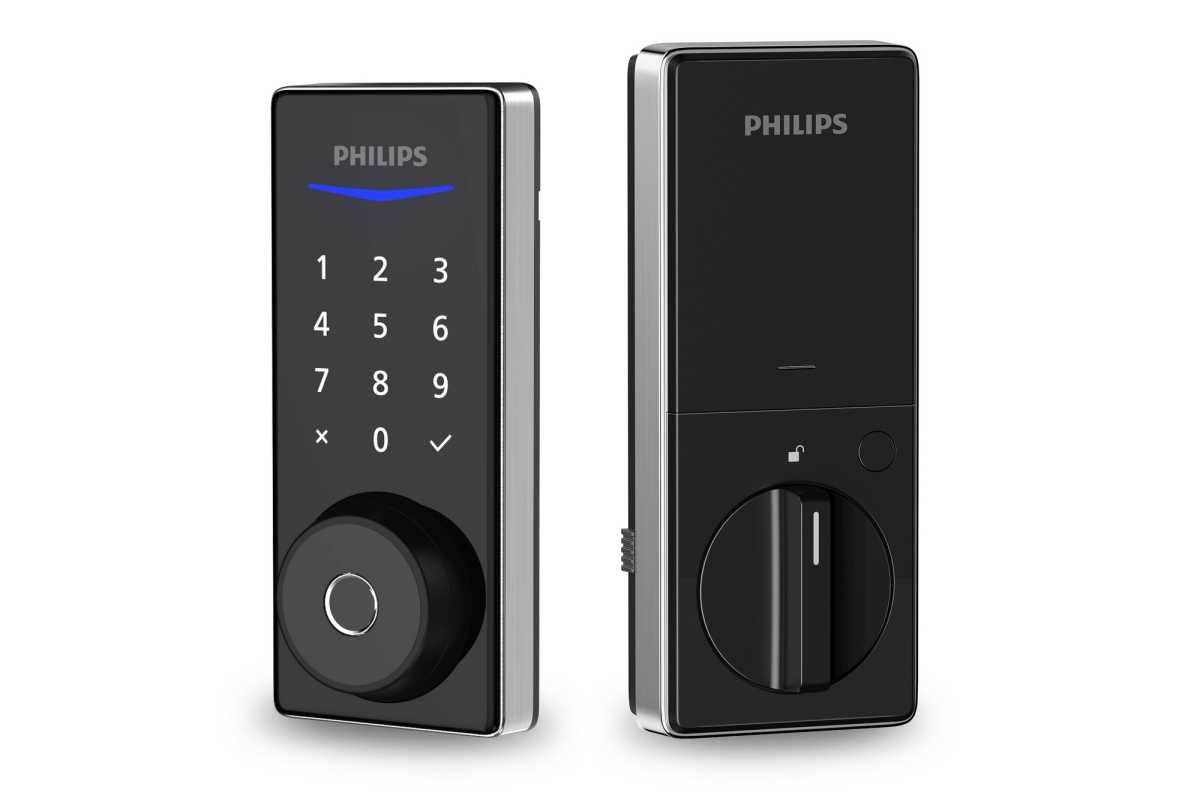Expert's Rating
Pros
- Attractively designed and sturdy exterior hardware
- Accurate and responsive fingerprint scanner
- Very reasonably priced
Cons
- It’s not a true smart lock
- Very difficult to physically install
- Manual programming via its keypad can be tedious
Our Verdict
Philips’ entry-level electronic deadbolt lacks any wireless features, but it’s better than the average dumb lock and it doesn’t cost much.
Best Prices Today: Philips 1000-series electronic deadbolt (model DDL210S-1H)
Philips makes a vast range of smart home gear, but it only recently entered the U.S. entry lock market with two series of smart deadbolts, one series of retrofit locks, and a series of entry-level electronic deadbolts, including the model DDL210S-1H reviewed here.
Note the distinction Philips makes between smart deadbolts (the 5000 and 4000 series) and electronic deadbolts (the 1000 series this lock is part of). The latter series lack any type of connectivity (there’s no Bluetooth or Wi-Fi radio onboard), so they can’t be controlled remotely with your smartphone, nor can they be integrated into a broader smart home system. This lock is for people looking for a simpler lock or who just don’t want to pay for a higher level of sophistication.
Once installed, I found the unit worked well, performing all its promised functions with grace.
First, let’s discuss the hardware. There’s nothing immediately shocking here, as the unit is designed as a traditional sandwich, with two bolts connecting a beefy exterior escutcheon to a metal plate that sits inside the door. An optional third bolt can be used at the top of the escutcheon to add support for the hardware to keep it from listing, but it’s not required, and I felt the lock was plenty sturdy without it. I found the connecting bolts difficult to engage properly, however, and one was quite difficult to turn, as if it had been imperfectly machined.

Philips 1000-series electronic deadbolts, including the model DDL210S-1H shown here, have all the features of a smart lock except any connection to the internet.
Philips
The Philips electronic deadbolt, model DDL210S-1H, can be unlocked with a PIN code entered on its numeric keypad, with a fingerprint scan, and with a physical key. There is one sort-of exception to the no-smartphone-control rule, which I’ll talk more about in a bit.
Installing the Philips 1000-series electronic deadbolt
A much bigger challenge awaited me when I attempted to connect the interior escutcheon to the metal plate. While typical smart locks connect via small screws, Philips uses tabs on either side of the escutcheon that clip to the metal plate. In theory, you just push the escutcheon against the plate, then slide the tabs down to engage it.
This review is part of TechHive’s in-depth coverage of the best smart locks.
In the real world, the electrical cable that snakes through the door and connects the electronics in the two escutcheons got completely in the way. There’s a rough channel that the cable is supposed to sit within, but the thick bundle of wires invariably popped out of it. I spent nearly 10 minutes trying to jam the two escutcheons together, and eventually had to use a screwdriver to wedge one of the tabs into place. Because the interior escutcheon is made of plastic, it ended up with a fair number of scratches from the endeavor. All told, installation headaches are a major drawback that I expect will frustrate many users.
Once installed, I found the unit worked well, performing all its promised functions with grace. The keypad—touch sensitive and backlit when it’s awakened by a touch—is responsive and easy to read, and fingerprints are easy to both register and use to unlock the device. Even a casual swipe of a registered thumb was effective at unlocking the deadbolt, which turns smoothly and quickly, followed by a voice prompt confirming the action was successful.
A physical keyhole secreted beneath the fingerprint scanner pivots out of the way to provide access to the key cylinder. You’ll want to keep that physical key handy, because the unit—powered by four AA batteries (included)—does not have an emergency backup power provision should the batteries die.
Philips 1000-series electronic deadbolts are not smart locks
As I’ve already mentioned, Philips’ 1000-series electronic deadbolts are not smart locks, at least not in the manner we’re accustomed to. They don’t have any kind of wireless radio, and they can’t be locked or unlocked with the Philips Home Access app. The app can, however, generate one-time-use PINs for the lock. These 11-digit codes expire after a single use, or if you change the lock’s master PIN.
You can’t use the app to manage the lock in any way. Everything must be managed by tapping on the lock’s touchscreen keypad. That includes registering PINs, enrolling fingerprints, and setting up the automatic-lock features (with options ranging from 30 to 180 seconds before the deadbolt re-engages. This feature is disabled by default.) You’ll need to refer to the lock’s user manual for this, especially at first, but they are all easy to complete—with a little patience.
Should you buy a Philips DDL210S-1H electronic deadbolt?
The lack of wireless connectivity limits what you can do with the lock considerably. There’s no logging, no way to limit PIN codes or fingerprints based on time or date, and no way to connect the lock to your smart home ecosystem. The device doesn’t detect whether the door is open or closed, either. If the door is left open and the auto-lock time arrives, it will fire away regardless.
Support for a maximum of 20 PIN codes (each one 4 to 10 digits long) and 50 unique fingerprints is fine for a device like this, as is the price: $120 at Amazon at press time, with a $30 code knocking the final price much less than $100. If you don’t need much in the way of frills or connectivity features, it’s a fair option to consider.



